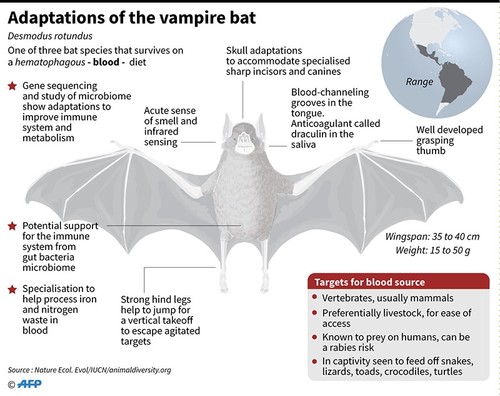© Turkuvaz Haberleşme ve Yayıncılık 2025
If you want to know how vampire bats can survive on a diet that consists exclusively of blood, the answer is simple. It's in their genes.
Scientists on Monday said they have mapped for the first time the complete genome of a vampire bat, finding that this flying mammal boasts numerous genetic traits that help it thrive on an exotic food source with few nutrients and many risks.
Blood is not only teeming with bacterial and viral disease, it is also very poor in nutrients -- too few carbs and vitamins, way too much salt.
But natural selection overcame these challenges and fashioned a genetic profile and intestinal ecosystem perfectly suited to a life of silent blood sucking.
The researchers compared the genome of the common vampire bat, scientific name Desmodus rotundus, to genomes of bat species that eat nectar, fruit, insects and meat. They also examined microbial DNA from its droppings.
 This bat and the world's two other vampire bat species, the hairy-legged vampire bat and the white-winged vampire bat, are the only mammals that eat just blood.
This bat and the world's two other vampire bat species, the hairy-legged vampire bat and the white-winged vampire bat, are the only mammals that eat just blood.
The common vampire bat, a nocturnal cave-dweller with a 7-inch (18-cm) wingspan, inhabits parts of Mexico, Central America and South America. It feeds on the blood of livestock such as cattle and horses. It lands near prey under cover of darkness, walks on the ground, then feeds on the sleeping animal using razor-sharp teeth to pierce the skin and a long tongue to lap up flowing blood.
"We decided to study this species because it has an 'extreme' diet, in the sense that it requires many adaptations in the organism to live on that," said study lead author Lisandra Zepeda, a University of Copenhagen doctoral student while doing the research published in the journal Nature Ecology & Evolution. "Blood is a challenging dietary source since it provides very low levels of vitamins and carbs, and a lot of proteins, salts and waste products."
They pinpointed genome elements that augment the bat's immune response and viral defense to cope with pathogens lurking in blood. They also identified genes involved in the metabolism of vitamins and fats that could help the bat deal with the unique nutritional aspects of its blood diet.
The bat's gut hosts an impressive arsenal of protective bacteria -- hundreds of which cause disease in other mammals -- that produce anti-viral substances.
Enter the microbiome, recently discovered to vary enormously not only from species to species, but from individual to individual within the same species (notably humans).
"We wanted to look at how the genome and the gut microbiome work together to overcome the challenge" of a blood-only diet, said co-author Tom Gilbert, among a growing number of biogeneticists championing the more inclusive concept of "hologenome."
Gilbert speculated that vampire bats might have eased into a pure-blood diet, starting with blood-gorged insects such as ticks and mosquitos.
"The beauty of it was that if they cracked the blood-diet code -- and they did -- then food became very plentiful, with not very much competition," he said by email.
"It was a big evolutionary win."
The three species of blood-drinking bats, all native to Latin America, have razor-sharp teeth that shave away hair before piercing their victims' skin and opening the spigot.
Chemicals in the saliva prevent blood from coagulating.
The common vampire bat feeds mostly on mammals, including humans, often returning night-after-night to the same animal for a meal.
Recent research has shown that D. rotundus can recognize individual humans by their breathing sounds, much in the way we can differentiate voices.
Vampire bats are also surprising generous, willing to share a (regurgitated) meal with a fellow bat that missed out, even if they are not related.
